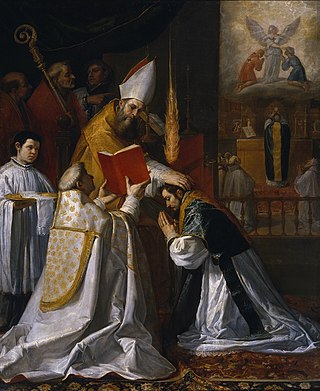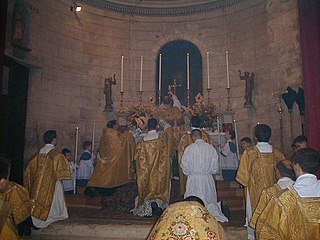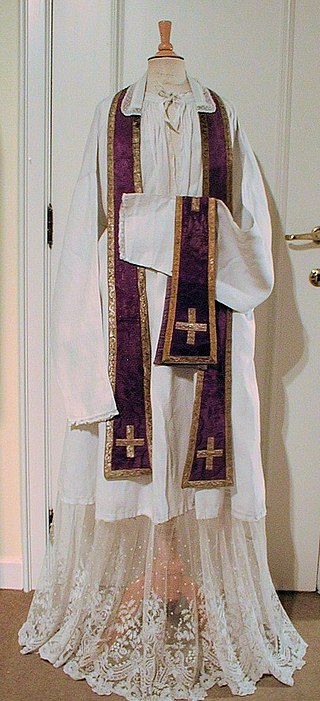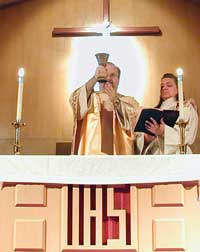
In certain Christian denominations, holy orders are the ordained ministries of bishop, priest (presbyter), and deacon, and the sacrament or rite by which candidates are ordained to those orders. Churches recognizing these orders include the Catholic Church, the Eastern Orthodox, Oriental Orthodox, Anglican, Assyrian, Old Catholic, Independent Catholic and some Lutheran churches. Except for Lutherans and some Anglicans, these churches regard ordination as a sacrament.
Methodism, also called the Methodist movement, is a group of historically related denominations of Protestant Christianity whose origins, doctrine and practice derive from the life and teachings of John Wesley. George Whitefield and John's brother Charles Wesley were also significant early leaders in the movement. They were named Methodists for "the methodical way in which they carried out their Christian faith". Methodism originated as a revival movement within Anglicanism originating out of the Church of England in the 18th century and became a separate denomination after Wesley's death. The movement spread throughout the British Empire, the United States and beyond because of vigorous missionary work, and today has about 80 million adherents worldwide.
The United Methodist Church (UMC) is a worldwide mainline Protestant denomination based in the United States, and a major part of Methodism. In the 19th century, its main predecessor, the Methodist Episcopal Church, was a leader in evangelicalism. The present denomination was founded in 1968 in Dallas, Texas, by union of the Methodist Church and the Evangelical United Brethren Church. The UMC traces its roots back to the revival movement of John and Charles Wesley in England, as well as the Great Awakening in the United States. As such, the church's theological orientation is decidedly Wesleyan. It embraces liturgical worship, holiness, and evangelical elements.

A deacon is a member of the diaconate, an office in Christian churches that is generally associated with service of some kind, but which varies among theological and denominational traditions. Major Christian churches, such as the Catholic Church, the Oriental Orthodox Churches, the Eastern Orthodox Church, Lutheranism, Methodism, and Anglicanism view the diaconate as an order of ministry.
The Evangelical Lutheran Church in America (ELCA) is a mainline Protestant Lutheran church headquartered in Chicago, Illinois. The ELCA was officially formed on January 1, 1988, by the merging of three Lutheran church bodies. As of 2022, it has approximately 2.9 million baptized members in 8,640 congregations.

An acolyte is an assistant or follower assisting the celebrant in a religious service or procession. In many Christian denominations, an acolyte is anyone performing ceremonial duties such as lighting altar candles. In others, the term is used for one who has been inducted into a particular liturgical ministry, even when not performing those duties.

Vestments are liturgical garments and articles associated primarily with the Christian religion, especially by Eastern Churches, Catholics, Lutherans, and Anglicans. Many other groups also make use of liturgical garments; among the Reformed (Calvinist) Churches this was a point of controversy in the Protestant Reformation and sometimes since, in particular during the Anglican ritualist controversies in England in the 19th century.

The stole is a liturgical vestment of various Christian denominations, which symbolizes priestly authority; in Protestant denominations which do not have priests but use stoles as a liturgical vestment, however, it symbolizes being a member of the ordained. It consists of a band of colored cloth, usually of silk, about seven and a half to nine feet long and three to four inches wide, whose ends may be straight or may broaden out in the shape of a spade or bell. The center of the stole is worn around the back of the neck and the two ends hang down parallel to each other in front, either attached to each other or hanging loose. The stole is almost always decorated in some way, usually with two crosses, or sometimes another significant religious design. It is often decorated with contrasting galloons and fringe is usually applied to the ends of the stole following Numbers 15:38–39. A piece of white linen or lace may be stitched onto the back of the collar as a sweat guard, which can be replaced more cheaply than the stole itself.

A scapular is a Western Christian garment suspended from the shoulders. There are two types of scapulars, the monastic and devotional scapular; both forms may simply be referred to as "scapular". As an object of popular piety, a scapular serves to remind wearers of their commitment to live a Christian life.

The Scapular of Our Lady of Mount Carmel belongs to the habit of both the Carmelite Order and the Discalced Carmelite Order, both of which have Our Lady of Mount Carmel as their patroness. In its small form, it is widely popular within the Latin Church of the Catholic Church as a religious article and has probably served as the prototype of all the other devotional scapulars. The liturgical feast day of Our Lady of Mount Carmel, July 16, is popularly associated with the devotion of the Scapular.

The Geneva gown, also called a pulpit gown, pulpit robe, or preaching robe, is an ecclesiastical garment customarily worn by ordained ministers and accredited lay preachers in the Christian churches that arose out of the historic Protestant Reformation. It is particularly associated with Protestant churches of the Reformed, Methodist, Unitarian and Free Christian traditions.

In some Christian denominations, a reader or lector is the person responsible for reading aloud excerpts of scripture at a liturgy. In early Christian times the reader was of particular value due to the rarity of literacy.

Our Lady of Mount Carmel, or Virgin of Carmel, is the title given to the Blessed Virgin Mary in her role as patroness of the Carmelite Order, particularly within the Catholic Church. The first Carmelites were Christian hermits living on Mount Carmel in the Holy Land during the late 12th and early to mid-13th century. They built in the midst of their hermitages a chapel which they dedicated to the Blessed Virgin, whom they conceived of in chivalric terms as the "Lady of the place." Our Lady of Mount Carmel was adopted in the 19th century as the patron saint of Chile.

Simon Stock, OCarm was an English Catholic priest and saint who lived in the 13th century and was an early prior of the Carmelite order. The Blessed Virgin Mary is traditionally said to have appeared to him and given him the Carmelite habit, the Brown Scapular. Thus, popular devotion to Stock is usually associated with devotion to Our Lady of Mount Carmel.

A religious habit is a distinctive set of religious clothing worn by members of a religious order. Traditionally some plain garb recognizable as a religious habit has also been worn by those leading the religious eremitic and anchoritic life, although in their case without conformity to a particular uniform style.

The General Conference, in several Methodist denominations, is the top legislative body for all matters within the denomination.

An elder, in many Methodist churches, is an ordained minister that has the responsibilities to preach and teach, preside at the celebration of the sacraments, administer the church through pastoral guidance, and lead the congregations under their care in service ministry to the world.
Presbyterian worship documents worship practices in Presbyterian churches; in this case, the practices of the many churches descended from the Scottish Presbyterian church at the time of the Reformation.

The following outline is provided as an overview of and topical guide to Christianity:

A sacrament is a Christian rite that is recognized as being particularly important and significant. There are various views on the existence, number and meaning of such rites. Many Christians consider the sacraments to be a visible symbol of the reality of God, as well as a channel for God's grace. Many denominations, including the Roman Catholic, Lutheran, Presbyterian Anglican, Methodist, and Reformed, hold to the definition of sacrament formulated by Augustine of Hippo: an outward sign of an inward grace, that has been instituted by Jesus Christ. Sacraments signify God's grace in a way that is outwardly observable to the participant.




















